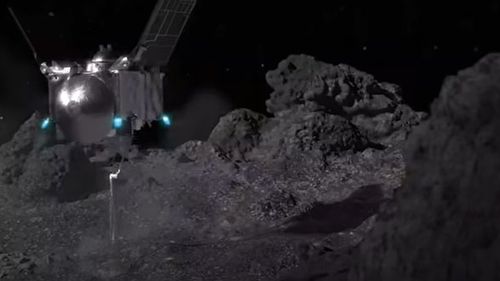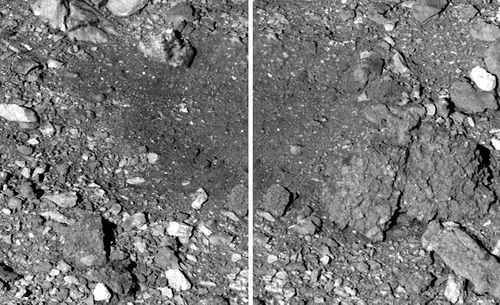New images captured by the spacecraft after a close flyby of the asteroid April 7 show the aftermath following the brief touchdown of OSIRIS-REx, which had collected 56 grams of rocky material.
During October’s historic Touch-and-Go collection event, the sampling head of the spacecraft sank half a metre into the surface of the asteroid. The robotic arm also fired a charge of nitrogen gas to help kick up material for collection.

The thrusters on OSIRIS-REx, which stands for Origins, Spectral Interpretation, Resource Identification, Security-Regolith Explorer, also helped to scatter rocks and dust as the spacecraft backed away after collecting the sample.
Images taken of the collection site, called Nightingale, before the event have been compared by mission scientists with the new images captured earlier this month.
The latest images reveal what looks like a depression in the surface with several large boulders at its base.
This was likely caused by the sampling event itself.
The dark surface of the asteroid also has more reflective dust near the collection point, showing where rocks were moved during the event.
These changes are evident in the slider below.
Disturbances caused by thruster activity are larger in scale.
Boulders appear to have been rearranged into a shape not unlike a campfire ring.
These resemble rings of rocks that are visible around small craters dotting the asteroid’s surface.

One boulder snagged the attention of the OSIRIS-REx researchers.
Spotted in one of the post-sampling images, the boulder measures about 4 feet across.
“The rock probably weighs around a ton, with a mass somewhere between a cow and a car,” said Jason Dworkin, the mission’s project scientist at NASA’s Goddard Space Flight Center in Greenbelt, Maryland, in a statement.
At first, the team couldn’t locate the boulder in any pre-collection event images.
But Dante Lauretta, the mission’s principal investigator at The University of Arizona, Tucson, suggested it was originally closer to the sampling site.
That means the sample collection threw it 12 metres away.

The April 7 flyby was planned out carefully to ensure that images captured of the asteroid would be applicable for comparison.
“Bennu is rough and rocky, so if you look at it from a different angle or capture it at a time when the sun is not directly overhead, that dramatically changes what the surface looks like,” said Dathon Golish, a member of the OSIRIS-REx image processing working group at The University of Arizona, Tucson, in a statement.
“These images were deliberately taken close to noon, with the Sun shining straight down, when there’s not as many shadows.”
The flyby took nearly six hours, and the spacecraft came within 2.1 miles of Bennu’s surface, which was the closest proximity between OSIRIS-REx and the asteroid since it collected the sample.
“These observations were not in the original mission plan, so we were excited to go back and document what we did,” Golish said.
“The team really pulled together for this one last hurrah.”
The OSIRIS-REx spacecraft will bid farewell to Bennu and depart the asteroid’s orbit on May 10, kicking off a two-year journey to Earth.
When the spacecraft nears Earth, it will release the capsule that contains the sample.
The capsule will parachute down at the Utah Test and Training Range.
The spacecraft will go on to investigate other asteroids.
This pristine return of samples from an asteroid, which could reveal information about Earth’s habitability, our solar system and how it evolved, will arrive on September 24, 2023.
The sample will be collected and sent to a special curation lab at NASA’s Johnson Space Center in Houston.
Scientists around the world will get the chance to study the asteroid sample and see what secrets are locked inside.
And much like the samples returned from the moon during the Apollo missions, 75 per cent of the sample will be locked away safely until future generations, and future technology, are able to study it and reveal even more.
This content first appear on 9news
